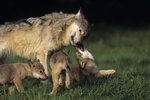
More than two centuries ago, trappers for the Hudson's Bay Company, trading in the fur of both snowshoe hare and lynx, noticed a curious phenomenon: Some years the landscape would be hopping with hares; other years they were ostensibly gone. When biologist Charles Gordon Hewitt analyzed records kept from 1820 to the early 1900s, he discovered a close connection between populations of lynx and hares. Understandably, lynx suffered when their main meal vanished from the menu -- but for a long time, the causes of these wild fluctuations in numbers of snowshoe hares mystified scientists.
Lynx Population Range
Canadian lynx (Lynx canadensis), often called the American lynx in the United States, is a relative of the bobcat. This lynx is identifiable by a short, black-tipped tail and tufted ears. All lynx live in forested areas, some populations farther north than others. Those native to the subarctic coniferous forest zone, or taiga, range throughout Canada's northland from Newfoundland and Labrador to Alaska. Farther south, lynx populations consist of smaller groups distributed over a wide range and geographically isolated from each other; they're seen in some of the maritime provinces of Canada and Minnesota, Montana, Idaho and Washington. These lynx live in boreal zones, forested regions in more temperate climes that have both deciduous and coniferous trees as well as lakes, rivers, wetlands and plains. Wherever you find lynx, you also find their preferred food source, snowshoe hares.
Snowshoe Hare Cycles
Every eight to 11 years, snowshoe hare populations undergo dramatic fluctuations in numbers, and scientists finally understand why. During peak years, when the hares dine well, they give birth to large, healthy litters. Soon, this results in a hare surplus that exhausts the available food supply. The animals begin to starve and, in their weakened state, lynx catch them more easily. Undernourished hares also produce fewer offspring, with newborns less robust and therefore less likely to survive. A study of pregnant wild hares published in the November 2009 "Journal of Animal Ecology" found that any kind of stress, not just fear of predators, caused a similar decrease in reproductive efficiency.
Lynx Cycles
For the lynx, feast rapidly turns into famine. After a year or two of decline, the hare population bottoms out and starvation starts stalking the cats. At first, they make do with rodents, squirrels and wild birds; but in terms of both quantity and quality, this prey is inadequate. When their nutritional needs aren't being met, lynx can't maintain the reserves of body fat necessary to survive in the cold climate. They're more vulnerable to predation and starvation, and the females can't provide their kittens with enough nourishment during gestation and afterward. According to the government of the Northwest Territories, such declines in lynx populations typically last three to five years. When food plants grow back unimpeded, and the hare population accordingly recovers, the lynx population follows suit.
The Global Warming Factor
Lynx expert Stan Boutin of the University of Alberta is concerned about the impact global warming will have on lynx-snowshoe hare cycles. Among three genetically distinct lynx subspecies isolated from each other by the Rocky Mountains or long distances, some pursue hare over crusty snow, which gives the cats the advantage, while others chase their quarry over fluffy snow, which gives the hares the advantage. Rising temperatures will result in fluffy snow turning crusty in some regions, thereby increasing the hunting success of lynx -- and influencing the cycle in ways that might have a negative impact on both animals, he says. Boutin calls this "one more way in which global warming is giving us an ecological warning."
References
- Encyclopedia Britannica Blog: The Rise and Fall of the Canada Lynx and Snowshoe Hare
- National Wildlife Federation: Can Lynx Survive Global Warming?
- Journal of Animal Ecology; The Sensitive Hare: Sublethal Effects of Predator Stress on Reproduction in Snowshoe Hares; Michael J. Sheriff et al.; November 2009
- Northwest Territories Environment and Natural Resources: The Lynx-Snowshoe Hare Cycle
- The IUCN List of Threatened Species: Lynx Canadensis
- The Canadian Encyclopedia: Fur Trapping
- Natural Resources Canada: Defining the Boreal
Photo Credits
-
Tom Brakefield/Stockbyte/Getty Images




